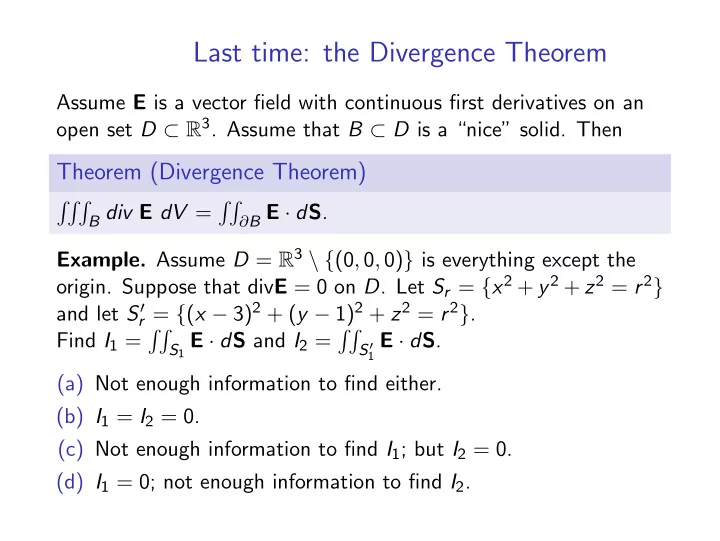

Last time: the Divergence Theorem Assume E is a vector field with continuous first derivatives on an open set D ⊂ R 3 . Assume that B ⊂ D is a “nice” solid. Then Theorem (Divergence Theorem) ∫︁∫︁∫︁ ∫︁∫︁ B div E dV = 𝜖 B E · d S . Example. Assume D = R 3 ∖ { (0 , 0 , 0) } is everything except the origin. Suppose that div E = 0 on D . Let S r = { x 2 + y 2 + z 2 = r 2 } r = { ( x − 3) 2 + ( y − 1) 2 + z 2 = r 2 } . and let S ′ Find I 1 = ∫︁∫︁ S 1 E · d S and I 2 = ∫︁∫︁ 1 E · d S . S ′ (a) Not enough information to find either. (b) I 1 = I 2 = 0. (c) Not enough information to find I 1 ; but I 2 = 0. (d) I 1 = 0; not enough information to find I 2 .
Solution Let B be any solid that doesn’t contain (0 , 0 , 0), so that B ⊂ D . (e.g. the solid inside the sphere S ′ r .) By the Divergence theorem, ∫︂∫︂ ∫︂∫︂∫︂ ∫︂∫︂∫︂ E · d S = div E dV = 0 dV = 0 . 𝜖 B B B Note that this argument doesn’t work for S 1 , because the solid inside of S 1 contains (0 , 0 , 0), so E is not defined over the whole solid, and the Divergence Theorem doesn’t apply. ∫︁∫︁ In fact, we will see later how to calculate S 1 E · d S explicitly for a certain example of E , and we will see that it’s not 0.
Announcements ∙ Final exam is next Friday. Register for conflict by Monday. ∙ Office hours/review session next week: • Ordinary office hours Tuesday 11–11:50am. • Extra office hours Wednesday evening (probably 6–7pm, maybe 7–8pm—it’s fine with me if you bring your dinner). AH 341 • Extra office hours Thursday 12–1pm. AH 341 • Possibly office hours also on Friday, but I can’t confirm yet. • Come with questions (or you can listen to other people’s questions). ∙ Fact: today is our ante-penultimate lecture. Wednesday was our pre-ante-penultimate lecture, but I forgot to say so.
Electric field and electric flux Given a particle of charge Q at (0 , 0 , 0), its electric field is Q E ( x , y , z ) = ⟨ x , y , z ⟩ 4 𝜌𝜗 0 ( x 2 + y 2 + z 2 ) 3 2 or equivalently Q E ( r ) = Inverse square law 4 𝜌𝜗 0 | r | 3 r . This means that the force experienced by a particle of charge q at position r is q E ( r ). Where is the vector field E defined? (a) all of R 3 (b) everywhere except (0 , 0 , 0) (c) everywhere except the z -axis, { x = y = 0 } (d) I don’t know
Practice with Gauss’ Law Suppose we have particles of charge Q i at points P i , with Q i = i for i = 1 , 2 , 3 , 4 , 5. Suppose that B is a solid region containing P 1 , P 3 , and P 4 , but not P 2 or P 5 . What is ∫︂∫︂ E · d S ? 𝜖 B (a) 0 1 (b) 𝜗 0 2 (c) 𝜗 0 4 (d) 𝜗 0 8 (e) 𝜗 0
Solution The enclosed charge is Q 1 + Q 3 + Q 4 = 1 + 3 + 4 = 8. So by Gauss’ Law, E · d S = 8 ∫︂∫︂ 𝜗 0 𝜖 B
Recommend
More recommend